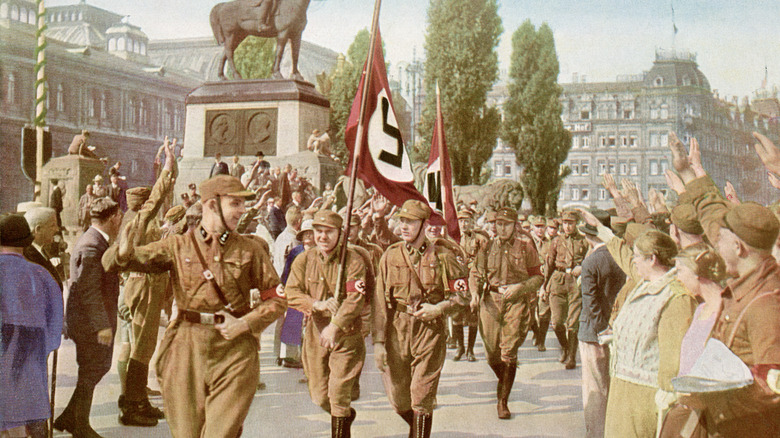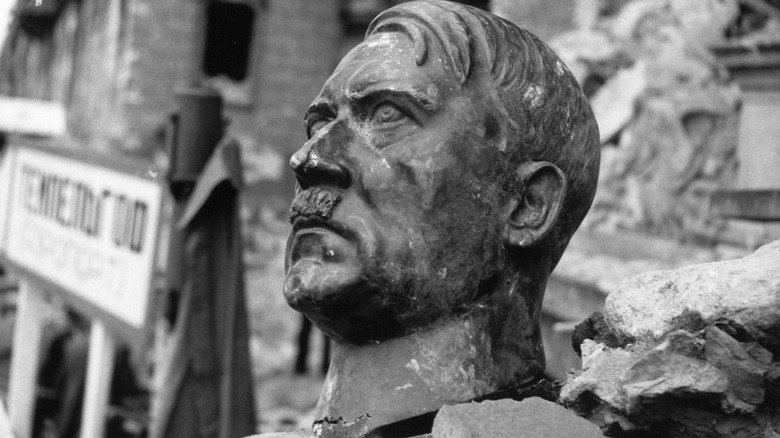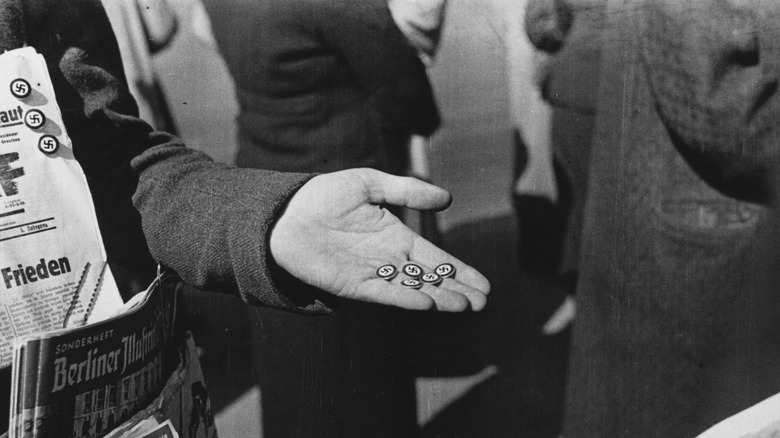What We Know About The Secret Stash Of Nazi Memorabilia Found In Argentina
They say that books are windows into other worlds. Whoever coined this profound remark undoubtedly had no idea it would ring equally true to a horrifying extent in June 2017, when a hoard of Nazi artifacts was unearthed in a secret room beneath a bookcase in Buenos Aires, Argentina (via Reuters).
In the wake of World War II, many leading Nazi war criminals evaded justice for the horrors of the Holocaust by fleeing the European continent for South America in the hopes of a safe haven. Using ”ratlines” or escape channels, many Nazis escaped from Italy (often with the help of the Vatican), or from the Middle East, and crossed the Atlantic (per History).
Although Argentina was neutral for most of the Second World War, only flipping to declare war upon Japan in the final months of the conflict, it turned something of a blind eye to an influx of war criminals after the fall of the Nazi regime (per Forbes). In the aftermath of the conflict, then-President Juan Domingo Perón, who was a Nazi sympathizer, thought that the war criminals he helped could be "useful" to him, according to The Vintage News.
As such, the country became something of a hotspot for many controversial historical characters. Adolf Eichmann, the architect of the Holocaust, and the loathsome "Angel of Death," Josef Mengele, fled to Argentina in the hope of avoiding capture. So, when this bizarre trove of Third Reich relics resurfaced in June of 2017, it further corroborated this ominous moment in history.
The Discovery
Like many secrets, this collection of relics was hidden in plain sight. Following a "UNESCO red alert,” the Argentina Federal Police raided the home of an antique dealer in a wealthy district on the outskirts of Buenos Aires, collaborating closely with Interpol and a United Nations taskforce dedicated to such investigations (per Washington Post).
This tip-off from the United Nations, led authorities straight to the collector, Carlos Olivares, who was suspected of trafficking illegal goods from China. Following a judicial order, authorities raided Olivares' home and uncovered a secret room concealed behind a bookshelf (via Reuters).
Not only was this discovery the largest harvest of Nazi artifacts in Argentina's history, but its contents list is incredibly perplexing. Each of the 75 unique items in this morose collection is just as peculiar as the last. Binoculars, battle medals, a phrenology skull-measuring instrument, a large commemorative dagger, a framed medallion with Hitler's likeness, photographs of the Führer, a statue of a Germanic eagle, children's games, and a wide variety of other propaganda paraphernalia were discovered (via History and Reuters).
The weirdest item was an Ouija board bearing Nazi insignia, which was typically used to make contact with spirits in the Victorian era. While it's oft-overlooked in history, the Nazis surprisingly had a predilection for the occult and regularly used occult symbolism and motifs in their warped worldview (per Big Think).
As for Olivares, his eventual fate remains unclear. The Guardian reported in 2019 that he would be charged and tried for breaking cultural heritage protection legislation and commercially exploiting Nazi artifacts of illicit origin.
The Collection's Fate
When the startling revelation was first made public in 2017, the story drew the attention of the world's media due to the sheer volume of the collection and its unlikely origins in an unassuming wealthy neighborhood. The collection's eventual fate and the insights it provides into such underground markets have been just as intriguing to follow over the years.
The initial plan for this trove of terrible treasures was for it to be donated to Buenos Aires' Holocaust Museum, with the intention that it would play a part in their grand reopening in 2019 and be used for educational purposes (per The Guardian). In preparation, German investigators and art historians were flown in to evaluate the authenticity of these items. Shockingly, they found that out of the 75 items discovered by police during the raid, only 10 of these were deemed reliably authentic (via CNN).
Dr. Stephan Klingen, one of these experts, told CNN that many of these artifacts were rife with spelling mistakes, or had Nazi insignias attached to them long after the heyday of the Third Reich. These modifications were made so that these items could be sold unwittingly to buyers in South America with a morose curiosity about Nazism. While the revelation that many of these items were forgeries undoubtedly dashed the hopes of many historians that these items had belonged to the Nazi regime's top brass, the fact that such a market even exists tells us a great deal about how societies are still trying to come to terms with the evils of Nazi Germany.


